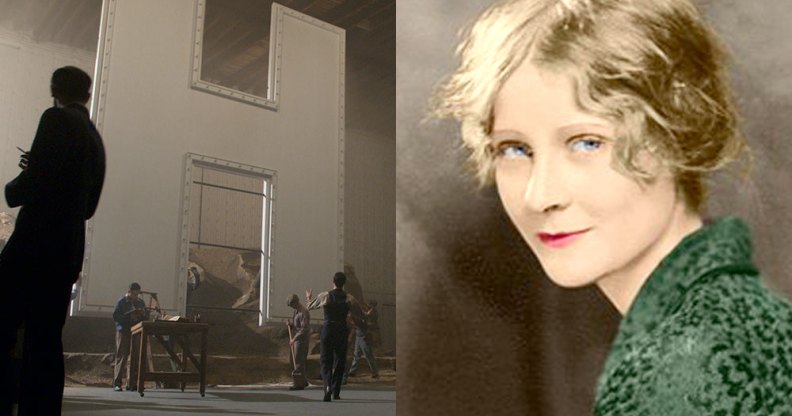The heartbreaking true story of Peg Entwistle, the actor whose tragic suicide inspired Netflix’s Hollywood

Peg Entwistle was found dead at the foot of the Hollywoodland sign’s H. (Netflix)
Hollywood gives Peg Entwistle and her tragic tale a happy ending, but in real life, the actor’s untimely death has served as a cautionary tale for young actors across generations. Caution: contains mention of suicide.
Hollywood is Ryan Murphy’s glossy retelling of the Golden Age, imagining what could happen if women, gay men and people of colour were allowed to succeed in 1940s Tinseltown. Driving the narrative is a movie-within-a-movie: Archie Coleman’s Peg.
While Archie is a fictional character, his script is based on a very real actor, the late Peg Entwistle.
Hollywood’s Peg movie – like the series itself – explores the inequalities of the film industry by examining what happened to Entwistle, who died by suicide after jumping off the Hollywoodland sign (now the Hollywood sign, after the latter part was removed in 1949).
In the show’s narrative Peg is renamed Meg so that the titular part can be recast with a Black American actor. In real-life, Peg Entwistle was a white British woman, born Millicent Lilian Entwistle in 1908 to English parents in Port Talbot, Wales.

Peg Entwistle becomes Meg in Hollywood. (Netflix)
Peg Entwistle moved to New York at a young age.
When Peg was 2 years old her parents divorced, according to biographer James Zeruk Jr. It has been claimed that her father was widowed, but this has never been substantiated.
Shortly afterwards, father and daughter emigrated to the US in 1913. Robert Entwistle was an actor himself, and settled in New York where he worked as a stage manager, remarried and had two sons.
It is said Peg’s movie and theatre ambitions were sparked when she saw the play Peg O’ My Heart as a young teenager in 1921, prompting her to rename herself after the show’s lead.
But her Broadway ambitions were put on hold by family tragedy in 1922, when her father was fatally hit by a car.
Then 14 years old, her life was uprooted as she and her two younger half-brothers were taken in by an uncle in Los Angeles, in what would later become the Hollywood Hills. (Robert’s wife, the boys’ mother, had died the year prior).
After tragedy, Peg made it to Broadway.
Peg managed to overcome her fractured and tragic childhood, fulfilling her dream of becoming a Broadway star.
By 1925 she’d starred in a number of productions in New York and in travelling productions, including a part in The Wild Duck which, according to legend, inspired a young Bette Davis to become an actor.
In 1927 she married another actor, Robert Lee Keith, and a year later both were invited to join the prestigious New York Theatre Guild.
According to Zeruk, the couple were sent on the road where Robert’s alcoholism and violent nature became steadily more apparent. In West Virginia, he was arrested for driving under the influence. In Michigan, he “viciously attacked” Peg as she was lying in their hotel bed, ripping handfuls of hair from her scalp as she screamed, until the house detective barged into the room and put a stop to the assault.
Robert wasn’t apprehended, and the pair reconciled for a while as he promised to stay away from alcohol. Eventually he relapsed, and Peg filed for divorce in 1929, citing mental anguish and abuse.

The original Hollywoodland sign. (Getty)
Peg Entwistle returned to Hollywood after her marriage broke down.
The breakdown of her marriage is said to have left Peg’s reputation in New York theatre circles tarnished, so she moved back to Hollywood. She continued to act on the stage, but by 1931 the Great Depression meant that theatre was struggling for its very survival.
The following year, Peg won a part in the RKO studio thriller Thirteen Women, which was to be her first and only on-screen role.
As Hollywood depicts, Peg’s movie part was mostly cut – not because of her performance, but because the studio thought the film was in violation of the Hays Code, which sought to keep pictures “wholesome”.
RKO informed Peg that she wouldn’t be retained on contract, and on September 16, 1932, she told her uncle that she was going to meet some friends at a nearby drug store.
Hours later, Peg’s body was found at the foot of the Hollywoodland sign, along with a note which read: “I am afraid, I am a coward. I am sorry for everything. If I had done this a long time ago, it would have saved a lot of pain. P.E.”
After her death, Zeruk says, her uncle received a letter addressed to Peg from RKO, offering her another film role.
Ryan Murphy says Hollywood was inspired by Peg’s life.
Peg’s tragic story became a “cautionary tale” for young stars trying to make it in Hollywood, according to Ryan Murphy.
“When I moved out to L.A. in the late ’80s, one of the first places I went was up to the top of the Hollywood sign,” he told OprahMag.com.
“There were tours where they would show you which letter she jumped off, and how she did it.”
Murphy said that the story illustrates one of his most oft-visited themes: “The idea that Hollywood can chew you up and spit you out and not really be fair.”
If you are struggling with your mental health and are based in the US, you can contact The Trevor Project Lifeline for free on 1-866-488-7386 (open 24 hours a day, 7 days a week).
In the UK, you can call the Samaritans for free on 116 123 (open 24 hours a day, 7 days a week) or call the LGBT Foundation helpline on 0345 3 30 30 30 (open Monday to Friday between 10am and 6pm).

